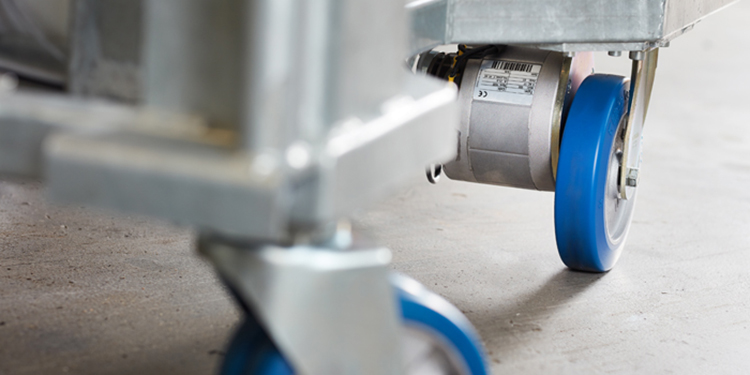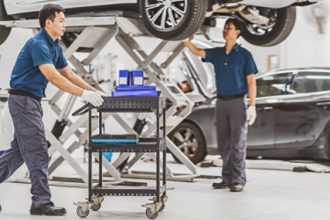Powered Wheels And Casters Make Strenuous Tasks Easier

Matching the optimal caster or wheel configuration — style, load capacity, tread material, and more — to a specific cart-based material handling application goes a long way toward increasing both worker ergonomics and productivity. However, for the ultimate ergonomic cart, one that virtually eliminates nearly all physical strains associated with pushing, pulling, starting or stopping a wheeled load on flat, inclined, or declined surfaces, consider utilizing wheels and casters powered by an electrical drive system. Carts equipped with battery-powered wheels start and stop with the push of a button, giving the operator total control over movement with minimal effort.
The majority of powered wheels and casters are offered as a complete system designed to match a specific cart and application. These systems can be applied to new cart designs or retrofitted to existing carts. For the optimal balance of strength, durability, rolling resistance, load bearing capacity, and hardness, most powered wheels and casters are outfitted with polyurethane treads. Because carts with power-driven wheels run at consistent speeds, tread degradation due to excessive heat build-up is highly unlikely in these applications.
These systems generally feature a drive wheel powered by a swappable battery with a full-shift run-time; stocking several charged batteries for fast exchange ensures the carts remain in operation as needed. The drive wheel is connected to an ergonomic handle and control panel positioned at an optimal height for the user. Starting, stopping, and speed control are directed by the operator who usually is required to push the handle forward to initiate and maintain movement. For safety, the drive system stops automatically when the handle is released. Further, systems include an emergency stop button for additional protection. Some are also equipped with integrated obstacle detection sensors to alert the operator to the presence of an object in the cart’s path with an audible alarm.
A design utilizing a single drive wheel can generally handle loads up to 1,200 pounds per wheel; the addition of a second drive wheel increases the handling capacity to as much as 1,700 pounds per wheel, as well as speed. As with all carts — manually operated or drive powered — load capacity is impacted by the number of wheels that maintain contact with the floor surface. When a loaded cart travels over an uneven surface, it is possible that not all the wheels will maintain contact with the floor. Therefore, the total capacity calculations are based on what amount of load weight three wheels can safely support.
Looking for more details on adding powered drive wheels to a new or existing cart application? For assistance, the members of the Ergonomic Assist Systems & Equipment (EASE) Industry Group of MHI are available to answer questions about ways to best optimize your operations’ ergonomics.



